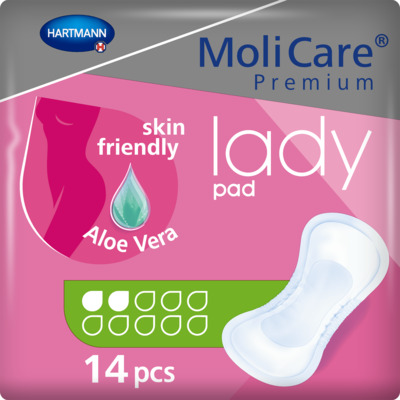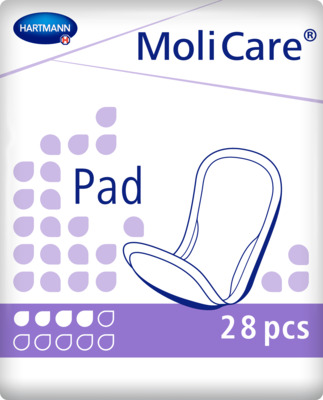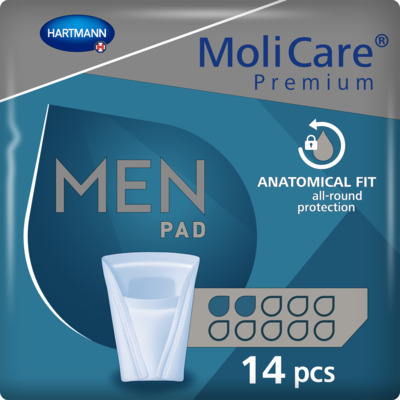Incontinence Advice
Incontinence After A Stroke: What You Need To Know
Experiencing incontinence after a stroke can be challenging and distressing. In this article, we will explore the ways a stroke can impact bladder and bowel functions, highlighting both the causes and effective treatments. We will also explain how strokes—whether ischemic or hemorrhagic—affect one's life and offer practical advice on managing and potentially improving stroke incontinence.

What Is A Stroke?
A stroke, often described as a "brain attack," occurs when the blood flow to an area of the brain is interrupted, leading to tissue damage and loss of function. The two primary types of a stroke include:
- Ischemic stroke: This type results from a blockage, often a blood clot, which impedes the blood supply to the brain. The resulting lack of blood causes critical brain cells to begin dying, severely affecting brain function.
- Hemorrhagic stroke: This type is caused by the bursting of a blood vessel either within or on the surface of the brain, this can lead to extensive damage due to bleeding.
Additionally, a transient ischemic attack (TIA), or 'mini-stroke', is the same as a stroke, but symptoms last less than 24 hours. It serves as a crucial warning sign of a potential full stroke and should be treated with immediate medical attention.
Recognising the symptoms of a stroke
The onset of a stroke is sudden and can include several alarming symptoms that necessitate urgent action. Recognising these signs can be the difference between recovery and significant disability. The FAST test is a quick way to remember the key symptoms, and stands for:
Facial weakness: Is there a droop on one side of the face? Can the person smile evenly?
Arm weakness: Can the individual raise both arms?
Speech difficulty: Is the speech slurred or hard to understand?
Time: If these symptoms are observed, it's time to call emergency services immediately.
Following a stroke, many survivors experience changes in bladder and bowel functions. This can include double incontinence, where control over both urine and faeces is lost. Damage to the brain areas that regulate these functions often results in misfiring signals that control the bladder and bowels. This can lead to the following symptoms:
- Urgency: An urgent, often uncontrollable need to urinate, typically caused by involuntary bladder contractions.
- Frequency: The need to urinate more often than usual, which can disrupt daily activities and sleep.
Nocturnal Enuresis: Involuntary urination during sleep, commonly referred to as bedwetting. Using incontinence bed protection can aid in managing this.
Urinary retention: Difficulty in emptying the bladder completely, which can lead to discomfort and further complications.
Stress incontinence: Leakage of urine during activities that increase abdominal pressure, such as coughing, sneezing, or heavy lifting.
Reflex incontinence: Involuntary urine leakage without any urge to urinate, due to brain damage affecting bladder control.
Constipation: A frequent issue for those who become less active post-stroke, leading to bowel movement difficulties.
Overflow diarrhoea: This occurs when stool, blocked by constipation, leaks around the blockage.
Approximately 50% of stroke survivors develop these issues, yet many regain control within a year post-stroke, highlighting the importance of proper management and treatment. Further signs and symptoms of a stroke can be found here
How a stroke affects the body
Beyond the immediate symptoms, the effects of a stroke can vary widely but often include:
Physical impairments: Physical weakness, often on one side of the body, noticeable in the face, arms and legs. Problems with coordination and balance, difficulty swallowing and difficulty with speech.
Cognitive impairments: Problems with memory, concentration, spatial awareness and understanding.
Sensory issues: Reduced sensation or numbness, altered sensation including tingling in the extremities, hypersensitivity, altered pain sensation, reduced balance and changes in vision and hearing.
Incontinence: Stroke can impair the brain's ability to control bladder and bowel functions, leading to incontinence after stroke. This can manifest as double incontinence, where both bladder and bowel control are lost, profoundly impacting one’s quality of life.

How a stroke can lead to incontinence
Incontinence after a stroke is a common outcome due to several factors:
- Damage to the brain: If the stroke has damaged the part of the brain that controls bladder and bowel function, this can lead to incontinence.
- Mobility issues: Reduced mobility may make it difficult for stroke survivors to reach the toilet in time, leading to accidents.
- Communication barriers: If a stroke has impaired speech or cognition, a person might struggle to express the need to use the toilet. They may also not be aware they need to go themselves until it is too late.
- Medication effects: Some medications for stroke recovery can exacerbate incontinence issues.
- Understanding these causes helps in managing the condition more effectively and with empathy.

Managing bladder and bowel function after a stroke
Seeking guidance from healthcare professionals is very important, as a tailored treatment plan for recovery from the stroke will be implemented. As part of this treatment plan, the underlying causes of any incontinence symptoms can be established, and the appropriate treatment commenced.
Addressing incontinence after a stroke involves a careful, considered approach that includes lifestyle adjustments, medical interventions, and supportive care.
Reducing risks:
Modifying diet to reduce bladder irritants like caffeine, acidic foods, and alcohol can alleviate symptoms. Ensuring a high-fibre diet and adequate fluid intake can help manage constipation. This is especially important for those looking to maintain a healthy lifestyle for over 50s. Further methods include:
- Maintain a Balanced Diet: Consuming a varied diet rich in fruits, vegetables, and whole grains helps manage weight and reduces stroke risk.
Regular Physical Activity: Engage in regular exercise to maintain a healthy weight and enhance cardiovascular health.
Manage Blood Pressure: High blood pressure is a leading cause of stroke. Regular monitoring and medication can control hypertension.
Reduce Cholesterol: Limiting the intake of saturated fats and focusing on heart-healthy foods can keep cholesterol levels in check. Consider having your cholesterol level checked at your surgery or pharmacy.
Quit Smoking: Smoking cessation significantly lowers the risk of stroke.
Limit Alcohol: Stick to recommended guidelines to minimise alcohol-related health risks.
Control Diabetes: For diabetics, maintaining blood sugar levels within recommended ranges is essential to reduce stroke risk. Further information can also be found in our diabetes and incontinence page.
Kegel exercises
It is crucial for stroke survivors experiencing incontinence to consult healthcare professionals who can tailor treatments to individual needs. This may include physical therapy for kegel exercises that strengthen the pelvic floor or medications to improve bladder control.
Treating stroke-related incontinence
Fortunately, many interventions can assist in managing incontinence after stroke:
Rehabilitative therapies: Physical therapy can strengthen pelvic muscles and improve bladder control.
Scheduled toileting: Some may question how many times a day to urinate. Properly setting a routine for bathroom visits can prevent accidents.
Use of continence products: Products like absorbent continence pads or specialised clothing can help manage incontinence discreetly and maintain quality of life. The Molicare premium elastic range are designed for those who have limited mobility or are bed bound.
About 15% of stroke survivors continue to experience incontinence issues a year after their stroke, but with the right treatment and strategies, improvement is highly possible. These measures not only aid in recovery but also help maintain dignity and improve the quality of life for stroke survivors.
Biofeedback and rehabilitation therapies
Biofeedback is a pivotal technique in treating bowel incontinence after a stroke. By using small electrical probes and sensors, it helps patients understand and improve their control over sphincter muscles through real-time feedback. This method allows stroke survivors to better manage and often regain bowel control, significantly reducing the occurrence of incontinence after stroke.
Physiotherapy and Occupational Therapy
Physiotherapy offers essential support for stroke survivors, focusing on strengthening exercises that improve mobility and coordination. Specific exercises tailored for the pelvic floor can also help regain continence, teaching patients to effectively manage bladder functions.
Occupational therapy complements this by adapting the patient’s living environment for safety and independence, with modifications such as installing handrails and using supportive devices like commodes and wheelchairs.
Medicinal Interventions
Managing constipation and bladder spasms is crucial in reducing incontinence after a stroke. Medications play a critical role including:
Laxatives: Such as bulking agents, osmotic, and stimulant laxatives help maintain regular bowel movements and prevent constipation-induced overflow incontinence.
Antispasmodic Medications: Medicines like Oxybutynin and Tolterodine alleviate bladder spasms, decreasing the frequency and urgency of incontinence episodes.
Injectable Treatments
For persistent incontinence, injectable treatments can be considered. These involve injecting a gel into the urethra or around the anus to bulk up the tissues and improve closure, reducing leakage significantly.
Further stroke advice and prevention can be found on the NHS website.

Managing incontinence after a stroke
Overall, managing incontinence after a stroke involves recognising the potential causes early to prevent further problems, as well as implementing effective treatments. It’s crucial to work closely with healthcare professionals so that they can refer you to the correct treatments that suit your needs, to allow for a more comfortable experience when handling incontinence after a stroke.

FAQs
Is incontinence permanent after a stroke?
Incontinence after a stroke is not necessarily permanent. Many patients experience improvements with proper rehabilitation and treatment, though the recovery time can vary widely depending on the severity of the stroke and the affected brain areas.
What are the signs of decline after a stroke?
Signs of decline after a stroke can include worsening of motor skills, increased confusion, difficulty with speech or swallowing, decreased cognitive function, and emotional instability.
How long does it take to get your balance back after a stroke?
Recovery of balance after a stroke varies significantly among individuals. Some may regain balance within a few months, while others might take a year or more, depending on the stroke's severity, affected brain areas, and rehabilitation effectiveness.
How long does aphasia last after a stroke?
The duration of aphasia after a stroke can vary. Some people may see improvements in a few months, while others may have long-term or permanent changes. The recovery depends on the stroke's severity, location, and timely rehabilitation.
Sources
Stroke Association. (2023) Signs and Symptoms. [online] Available at: https://www.stroke.org.uk/stroke/symptoms [accessed 09/05/24]
NHS. (2018) Prevention: Stroke. [online] Available at: https://www.nhs.uk/conditions/stroke/prevention/ [accessed 09/05/24]

MoliCare® Premium Lady Pad 2 Drops
<h2>Skin Friendly Pant Liners</h2> <p>For women that experience slight incontinence and bladder weakness, across different age groups, it can be a challenge to find the right bladder weakness product that is easy to apply and wear without the worry of potential leakages. Fortunately, we understand this approach, hence why we are happy to offer our MoliCare® Premium Lady Pad 2 drops, that is skin-friendly, Aloe Vera applied, and comes with 14 liners per bag.</p> <h2>Slim and discreet liners</h2> <p>Whether dealing with stress incontinence or urge incontinence, these panty liners offer a discreet and easy solution on the go. Simply place the pad in your underwear and secure it with the adhesive strip for all-round protection. Available in different absorbency levels, MoliCare® bladder weakness products cater to all levels of bladder weakness, ensuring secure care.</p> <h2>Control Bladder Weakness</h2> <p>Enjoy the benefits of these body-shaped absorbent panty liners, designed for women with bladder weakness. The pads offer discreet, reliable protection with features including odour control and fast absorption.</p> <p>With a wide adhesive strip, you can comfortably fix the pad in your regular underwear, providing secure and comfortable fixation. The pads are skin-friendly, featuring soft, breathable materials, including foam cuffs, and a top sheet treated with Aloe Vera.</p> <p>Keeping your skin healthy is a priority, which is why MoliCare® Premium Lady Pads have a skin-neutral pH value of 5.5 and an antibacterial finish. They are also dermatologically tested, offering peace of mind.</p> <h2>Buy pant liners online</h2> <p>Never worry about running out with our convenient order service and fast delivery direct to your door. Enjoy free shipping on orders over £50.</p> <p>If you need assistance, our professional customer service team is here to support you in choosing the right product. Reach out to us today at 0800 028 9470 and experience the comfort and reliability of MoliCare® Premium Lady Pads.</p>
MoliCare® Premium Men Pad 3 Drops (ISO 441ml)
<p><strong>Reliable and discreet incontinence pads for men with an instant-dry feeling</strong></p> <p>Bladder weakness is difficult to live with, the last thing you want to worry about is incontinence protection. That’s why our best-ever MoliCare® premium MEN Pad 3 drops offer an <strong>all-round protection</strong> that keeps everything dry and comfortably in place while fitting discreetly in your regular underwear.</p> <p>The incontinence pad for men quickly <strong>removes urine from the surface up to 86 %* faster than before</strong> and neutralises unpleasant odours to leave you feeling instantly dry and in control thanks to the new <strong>MoliCare SkinGuard</strong>®<strong> Absorbent Core Technology</strong>. This skin-friendly technology not only helps you feel up to 90 %* drier than previous MoliCare® premium<strong> </strong>MEN pads, it also helps to maintain healthy skin and preventing irritation.</p> <p><strong>Engineered for the male anatomy</strong> and dermatologically tested for maximum skin compatibility, these male urinary pads do not contain colour, perfume or latex making them environmentally friendly too.</p> <p>*Compared to last generation</p>
MoliCare® Pad 4 Drops
<h2>Handy MoliCare incontinence pads to carry on the go</h2> <p>Our MoliCare® Pad 4 Drops are an essential product for those experiencing slight incontinence, allowing you to regain control and live your busy and active life without the interference of bladder weakness. Designed for both men and women, this incontinence pad for men and women offers exceptional dryness and protection, ensuring your comfort and confidence.</p> <h2>‘Barely There’ Reassurance and Reliability</h2> <p>The MoliCare® Pad 4 Drops are slimline, discreet, and adjusted to fit your body seamlessly. It fixes securely inside your underwear, providing a ‘barely there’ comfort feel. With its soft and skin-kind fabric, along with a wide adhesive fixing strip on the backsheet, you can go about your day with the assurance of being protected against leakages.</p> <p>The absorbent core effectively prevents your skin from becoming too moist, while the elastic anti-leak edging adds an extra layer of security and peace of mind. Say goodbye to any worries about odours, as the MoliCare® Pad 4 Drops also neutralises odours to keep you fresh and confident throughout the day. Don't let incontinence hold you back from living life to the fullest.</p> <p>Ordering your MoliCare® Pad 4 Drops is hassle-free, as we offer fast delivery direct to your door. With our price match promise, you can trust that you're getting the best value for your money. Plus, enjoy free delivery on all orders over £50.</p> <p>If you need assistance in finding the perfect incontinence product for your needs, our friendly customer care team is here to help. Don't hesitate to reach out to us at 0800 028 9470. Take control of your life with the reliable protection and comfort of the MoliCare® Pad, alongside other <a href="https://www.hartmanndirect.co.uk/incontinence-products/incontinence-pads" style="color:#0563c1; text-decoration:underline">incontinence pads</a>.</p>
